Symmetry is wonderful in jewelry design. It is pleasing to our eyes and lends a sense of balance and completion. This week, we wanted to a share another blog about color, by Margie Deeb. Margie explores parallel colors in a design. Analogous colors create movement on a jewelry design or piece of art. They are warm or cool and convey that feeling.
Margie has written books and given lectures about the nature of color. She is a color guru. If you would like to simplify things, she has a colorwheel available on her site that is an invaluable asset and so easy to use. Design with color in mind. A knowledge of how color works will make your jewelry radiate!
Explore color! Trios Color Wire is a lead-free beading wire for designers that want to create jewelry with color mixing in mind. Trios Color Wire Sets encapsulate the vivid palette of nature and the glamour of the fashion world. Trios Color Wire Sets are comprised of three 10 foot spools of Soft Flex Wire. Fill your jewelry making kit with color!
We love Margie Deeb's intimate knowledge of colors and we wanted to re-share some of our archive articles she has written for us. Margie is an incredibly talented artist, designer, and author. Follow along on her color journey. Let's all become students of color!
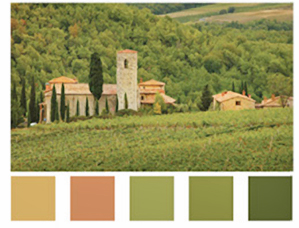
I'm often asked how to use the colorwheel. That question takes considerable time to answer (it took me four years and 144 pages to answer to it thoroughly in
The Beader's Guide to Color). But it's a question that deserves an answer short enough to introduce you to the most valuable color tool I know.
I now have a shorter answer for you: the
Instant Color Wheel Guide, a PDF download for $3.95. I've designed this digital publication so that in 10 minutes or less you'll understand the basics of using the color wheel, and you'll no longer be confused or intimidated by it. It's easy to understand, and full of examples.
Let me tell you about my approach to using color. Then we'll explore one of my favorite color schemes using some of the material from the
Instant Color Wheel Guide.
Before I make any color decisions I always ask myself (and answer myself) these kinds of questions:
What impact do I want my finished color scheme to have?
How do I want the viewer to feel when they see it?
What am I trying to convey?
The color scheme you choose to work with will depend on the answers to these most critical questions. The descriptive words at the top of each page of the guide will help you answer the questions; they give a broad view of nature of the color scheme.
For example, let's say you want a color scheme that is evocative, poetic, harmonious, and easy to work with. That fits the description of the analogous color scheme. Let's look at it ...
Highpoints of analogous color schemes:
- 2 or more colors adjacent to each other on the wheel (including pure hues, shades, and tints)
- They create gentle movement because the colors are similar
- They are temperature specific, leaning toward warm or cool
- To maintain the overall mood use no more than 4 analogous colors

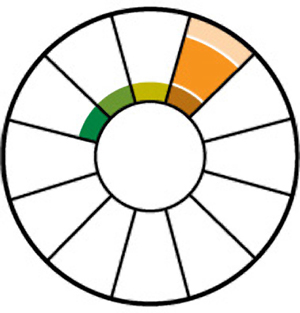
For depth and complexity, combine pure hues, tints, and shades of your analogous harmonies.
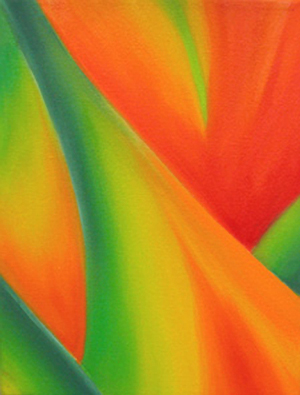
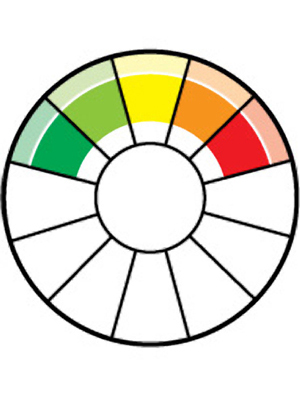
“Heliconia” oil on canvas by Margie Deeb
Because of their proximity, adjacent colors are intrinsically harmonious, making them easy to combine successfully.
Analogous schemes fill our world: the iridescence of peacock feathers, the changing blues and greens under the ocean, and the yellow-to-pink gradations of a lotus blossom.
The analogous palette has a mellifluous quality. Its colors swirl and flow into one another, defying boundaries. Where does blue end and blue-green begin? The analogous palette seeks no answer. It just revels in the mystery of movement.
Join our Facebook group – VIB. Stay in the know. Stay up to date. From our bead shows to our video shows and sales, you can stay in touch with us. The community is full of artistic and helpful beaders and crafty people. Inspire and be inspired. Share your pictures and get the beading bug from others!
Visit the Soft Flex Company YouTube Channel!
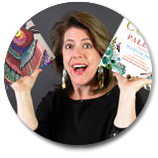
Artist and color expert Margie Deeb is the author of The Beader's Color Palette, The Beader's Guide to Color, The Beader's Guide to Jewelry Design and numerous beading and color publications. She teaches color and beading across the country and her free monthly color column, Margie's Muse, is available on her website. She writes regularly for Beadwork, Bead & Button, and Step-by-Step Beads magazines.
Visit Margie's website for her books, kits, patterns, jewelry, inspiration, and more: www.MargieDeeb.com




